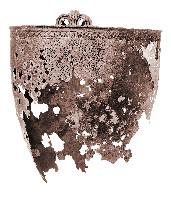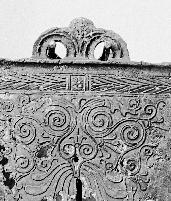The Bronze Bucket from Keldby
The Bronze Bucket from Keldby was found in 1826. We do not know exact where, but we do know that it wasplowed up on a hill named Trehøje near Keldby on the island Møn. The bucket may well have served as a burial urn. Other valuable imported bronze vessels - as the Etruscan wine vessel from Tinghøj in Himmerland - ended up as an urn for burnt bones.
The old bronze bucket
The bucket from Keldby was made around 300 BCE. There have been various suggestions as to how it is made. One of the theories is that its origin is in Corinth, near Athens, it may come from the workshops of the Greek colony of Taranto in southern Italy - or perhaps from one of the many Greek colonies on the Black Sea. Some have argued that it is produced by the Etruscans under Greek influence. In all cases it shows the beautifully crafted palmette ornament, which almost forms whirls. These indicate Greek-inspired craftsmanship. The Greek world was great back then, with colonies and cities almost everywhere in the Mediterranean and Black Sea. The name "Keldby-bucket" may sound a bit dry and sad. It is easy to think of a bucket. But it is far more inspiring than its name. We are facing a beautiful Greek bronze vessels, which in the south is used as containers for wine in celebration and drinking. A servant has carried the bucket in the handles, and with ladles wine was poured into drinking pots.


The bronze bucket - or rather the wine container - has been used for a number of years beforeit ended in Denmark. Through different connections, perhaps via Celtic princes in Central Europe it finally reached Møn. The Keldby bucket is not the only one. Other exclusive bronzes, as the Etruscan kettle from Mosbæk in Himmerland, came up here via a network of connections that were established during the last half of the Pre-Roman Iron Age. Perhaps a great man from Møn used his bronze in the same way as far south, but certainly with domestic drinks and local fruit wine. Finally, he was buried in his finest vine vessel in an ancient burial mound with great views of the landscape of Møn.
